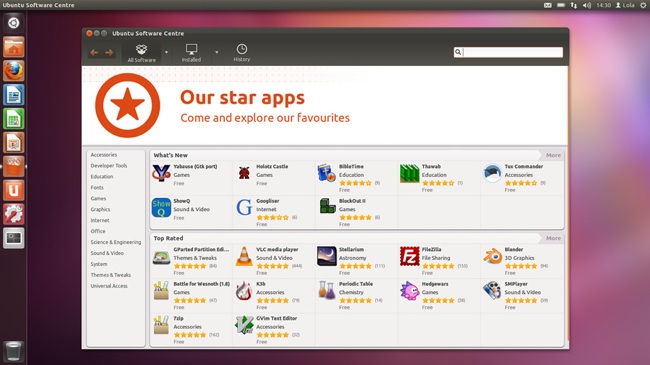During the month of October, most people are getting ready to celebrate Halloween, but serious computer geeks also have another tradition. October is one of two months each year months that a new Ubuntu version is released, and version 11.10 of the Linux distribution, dubbed “Oneiric Ocelot” is available for download.The last version, 11.04, introduced the slick but controversial Unity interface, but Ubuntu left the classic GNOME desktop in for those who didn’t want to switch. Now Unity is the only version available, along with “Unity 2D” interface for slower computers. If you’re a serious Linux geek, you can always install GNOME or any other window manager/desktop environment you wish, of course, or even (gasp!) use another distro.
Launching applications and finding files is also easier. Ubuntu has revamped the Dash to make it actually pleasant to use. The Dash is accessed from an icon that appears on the Launcher, similar to the Dock in Mac OS X or the Taskbar in Windows. Just click it and you’ll be presented with a search box and the ability to launch some tasks quickly, such as checking your email and listening to music. You can search your system generally or narrow your focus down with “lenses” that let you search for applications, files, and even music. You can get even more specific by searching for documents or images if you’re in the files lens or games in the applications lens, for example. You can even see applications available in the Ubuntu Software Center available for installation.
There are a few changes to the default applications. Mozilla’s Thunderbird is the new default email program, replacing the email and calendar application Evolution. Ubuntu’s basic social media client, Gwibber, has been revamped, featuring a slick new interface.
Another change that might seem a bit odd is the window controls. The minimize, maximize, and close buttons as well as the menu bar are hidden until you hover over them. Ubuntu has always had a clean design, and perhaps the developers thought that they cluttered up the screen, but the effect is jarring if you’ve spent your whole computing life with them always visible. Still, this is only a minor change.
If you’re used to Windows and the Alt-Tab application switcher, you’ll be relieved that Ubuntu has one as well. But the really cool feature is the ability to see a preview of a Window by holding the down arrow key while hovering over an icon. You can also switch between windows, like Mac OS X’s Exposé, with ALT-`.
And speaking of he Ubuntu Software Center, this is another app that’s been totally overhauled for this release. The interface has been completely redesigned into something that could give Apple a run for its money. One of Ubuntu’s greatest strengths has been the ease of installing software, and that hasn’t changed. In addition to the thousands of free apps, you can also purchase some paid programs, if you so choose, though free and open source purists may scoff at the idea. A good chunk of the paid apps are games.
This is a release worth checking out, either by installing or using a live CD or thumb drive. There’s even a neat interactive tour on the Ubuntu website.We covered the previous release, Ubuntu 11.04 and how to install Ubuntu without wiping out Windows.











